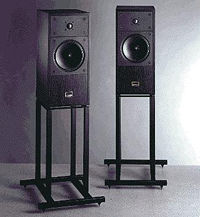Why can’t man develop an accurate loudspeaker if he can put cars on Mars and perfect open heart surgery? Modern speakers are severely hampered even under the best of circumstances, and the chance of getting one to perform correctly from 20Hz to 20kHz is still a long way off.
Given that moving coil drivers are sullied by a variety of colorations and that electrostatics only work over a narrow frequency range, engineers must use innovative tactics to get the most out of them. Yamaha determined that Beryllium domes were the answer in the early 1970s, and the NS-1000 was born.
Yamaha developed treble and midrange speakers with extremely low distortion, good dispersion, and phase coherence using this pricey alloy. They operated similarly to an electrostatic panel when linked together by a sophisticated crossover network, but with longer extended highs and better power handling. The combo was dynamite when paired with a fast, light, rigid paper coned 300mm bass unit.
The first NS-1000s were released in 1975, and they were built like a brick powder room, complete with HF and mid-range trim pots incorporated into the front baffles. Their high-tech engineering and exceptional 32kg per box structure were reflected in their price of almost £400. They sounded like a Quad ESL with a ribbon super-tweeter and a sub-woofer to handle the lows, and no one had ever heard anything like them!
They were greeted enthusiastically in Japan and the United States, with recording studios and broadcasting firms pouring money into Yamaha. Simply said, no other speaker could match the NS-1000’s blend of transparency, speed, and power handling. However, there were conflicting replies in this area. Reviewers who were accustomed to gentle, bland Bextrene coned BBC monitors found them upfront and tiring, with a tendency to roughness and fizz.
The issue was that the Yamahas were incredibly harsh on the amplifiers that powered them. Most Japanese audiophiles used them with muscular valve amps with a warm, smooth sound because of their great sensitivity and relatively easy load. Big punchy transistor power amps like Naim’s NAP250 were all the rage in the UK, and without soft Bextrene or polypropylene coned speakers to hide behind, they could sound – yeah, that’s right – upfront, fatiguing, and bubbly!
In 1978, the NS-1000s received new cabinets that were somewhat smaller and more sturdy, as well as black paint and a ‘M’ suffix. When they were re-reviewed by the UK press, they were panned as harsh – with the exception of Practical Hi-Fi, whose reviewer used them with the (at the time, extremely out-of-fashion) Quad II and awarded them a giant thumbs up. That’s amusing.
Because the last NS-1000Ms cost about £2,000 nearly two decades ago, second-hand NS-1000Ms are not inexpensive; expect to pay between £800 and £1,200 depending on age and quality. Look for the phrase “one careful owner” and steer clear of instances that sound bubbly, as this indicates a disturbed Beryllium driver on the verge of dying. Replacements are now extremely difficult to come by.
With dazzlingly rapid transients, remarkable soundstaging, and great clarity and detail, the NS-1000Ms are one of the most transparent sounding speakers ever produced. They also have the ability to add life, drama, and scale onto everything they touch, similar to JBL — a tremendous mix of qualities! You’ll struggle to find a speaker that’s as much fun if you pair them with valves or Class A tranny power amps, adjust the mid range trim pot down to –3dB (they do have a tiny mid-forward balance, but this mitigates it), and place them on strong stands. It’s deafeningly loud!







